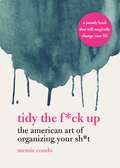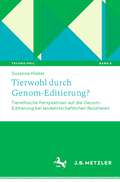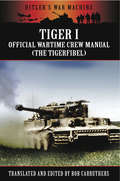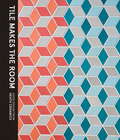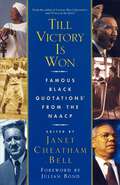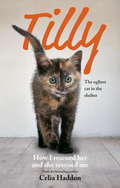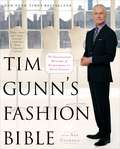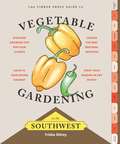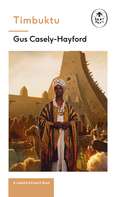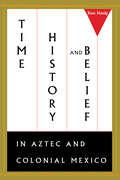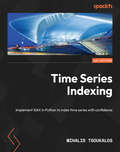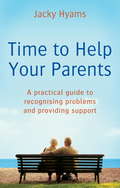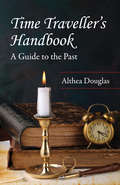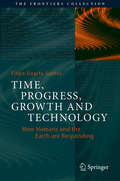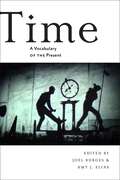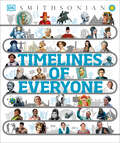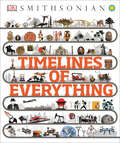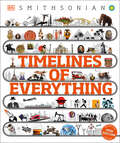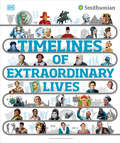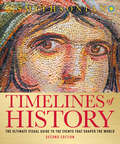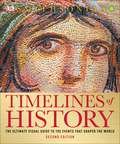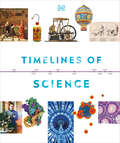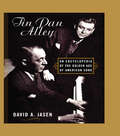- Table View
- List View
Tidy the F*ck Up: The American Art of Organizing Your Sh*t
by Messie CondoEven you can get your sh*t together!Tidy the F*ck Up is a funny, down-to-earth parody of Marie Kondo’s The Life-Changing Magic of Tidying Up, where you’ll be handed the most useful tools for keeping your crap clean and organized without all the pressure. In this book, you’ll discover useful ways to figure out what to do with your sh*tpiles in an approachable, care-free way, and you’ll say farewell to the hair-pulling stress of marathon cleaning. Tossing all your junk in a closet doesn’t make it any less of a clusterf*ck, but approaching it little by little and making use of some helpful hints can do a world of wonders for all your sh*t, the comfort of your space, and your general sanity. With this hilarious guide, you’ll learn how to: Become a decision-making bad*ssGet rid of the sh*t you don’t need and keep the sh*t you doLive life after a clusterf*ck!And more! With a lighthearted tone that the finest sailors would admire, Tidy the F*ck Up will help you make your house a f*cking home.
Tierwohl durch Genom-Editierung?: Tierethische Perspektiven auf die Genom-Editierung bei landwirtschaftlichen Nutztieren (Techno:Phil – Aktuelle Herausforderungen der Technikphilosophie #8)
by Susanne HiekelDer Einsatz neuer biotechnologischer Verfahren, wie der der Genom-Editierung, hat die Debatte um die ethische Zulässigkeit einer gentechnischen Veränderung von Tieren neu entflammt. Die Motivation zu genomeditorischen Züchtungsvorhaben ist, so wie bei „konventionellen“ Vorhaben auch, zumeist produktions- und leistungsorientiert. Es gibt vereinzelt aber auch Vorhaben, die darauf abzielen, dem tierlichen Wohl zugutezukommen. Dieser Zusammenhang des „Tierwohls durch Genom-Editierung“ wirft einige Forschungsfragen auf: Wodurch sind die Verfahren der Genom-Editierung in der Nutztierzucht überhaupt charakterisiert? Wie lässt sich das Anwendungsspektrum von genomeditorischen Nutztier-Zuchtvorhaben, die das tierliche Wohl befördern sollen, genauer beschreiben? Ist das Wohlergehen „zukünftiger Tiere“ überhaupt von moralischer Relevanz (Problem der Nicht-Identität)? Sind genomeditorische Zuchtvorhaben möglicherweise generell abzulehnen, weil sie die Integrität der betroffenen Tiere verletzen? Wie sind genomeditorische Zuchtvorhaben, die das Wohl von landwirtschaftlichen Nutztieren befördern sollen, aus tierwohltheoretischer Perspektive zu beurteilen? Wie – falls überhaupt – lassen sich Handlungen rechtfertigen, die zwar einerseits zur Perpetuierung einer moralisch problematischen Praxis beitragen, andererseits aber in bestimmter Hinsicht gegenüber dieser problematischen Praxis eine Verbesserung bedeuten? Antworten auf diese Fragen stellt dieses Buch bereit.
Tiger I: The Official Wartime Crew Manual (Hitler's War Machine)
by Bob CarruthersThe original how-to manual for handling the German tank in World War II, edited and translated by the Emmy Award-winning historian and author. During the Second World War, Tiger tank crews had to be trained as quickly and effectively as possible. To assist in this process General Heinz Guderian authorized the publication of the Tigerfibel, the illustrated manual which was issued to Tiger I crews from 1943 onwards. This highly unorthodox publication was full of risqué drawings and humorous illustrations and was designed to convey complex battlefield instructions in a simple and memorable manner. This unique primary source has now been translated into English by Emmy Award-winning historian Bob Carruthers and published with a new overview and introduction. It makes for indispensable reading for anyone interested in tank warfare in World War II. The manual contains everything the reader could ever wish to know concerning how the crews were instructed to handle the Tiger I under combat conditions, including detailed instructions on aiming, firing, ammunition and close combat. There are extensive sections on maintenance, driving, radio operation and the essentials of commanding the heavy tank. This priceless information is now being made available to a wider English-speaking audience as an electronic publication for the first time. Fascinating and highly accessible, the Tigerfibel is essential and rewarding reading for all those interested in the history of this famous tank. This book is part of the Hitler&’s War Machine series which draws on primary sources and contemporary documents to provide a new insight into the true nature of Hitler&’s Wehrmacht.
Tile Makes the Room
by Catherine Bailey Robin PetravicFrom Heath Ceramics, the beloved California designer, maker, and seller of home goods, comes a captivating and unprecedented look at tile. At its core, Tile Makes the Room is about exceptional spaces and places--the kind you want to step into and examine each and every detail of--where tile is the main ingredient, though not the only star. From the dwellings of notable designers to everyday homeowners, grand installations and subtle designs all showcase tile's role in the form and function of architecture and interiors. With inspiration on every page, a look at tile making from a sixty-year-old design-led manufacturer, a unique perspective on color, pattern, and texture, plus public installations around the world to visit and enjoy, Tile Makes the Room is essential reading on tile and interiors.From the Hardcover edition.
Till Victory Is Won: Famous Black Quotations From the NAACP
by Janet Cheatham BellTaking its title from the moving lyrics of the official song of the National Association for the Advancement of Colored People, "Lift Every Voice and Sing," Till Victory Is Won chronicles significant moments in African-American history through more than two hundred illuminating quotations from NAACP officers, members, and award recipients. Focusing on five major topics -- Protecting Civil Rights, Achieving Educational Excellence, Nurturing Economic Development, Reaching Youth, and Gaining Political Power -- this extraordinary anthology inspires and informs. Featured voices include: Kweisi Mfume Duke Ellington Rosa Parks Hank Aaron Carter G. Woodson W.E.B. Du Bois Thurgood Marshall Maya Angelou Harry Belafonte Sidney Poitier Sara Lawrence Lightfoot Martin Luther King Jr. Halle Berry Michael Jordan Earvin (Magic) Johnson Colin Powell George Washington Carver Jesse Jackson Oprah Winfrey Lauryn Hill Henry Louis Gates Jr. Toni Morrison Susan Taylor Langston Hughes Jackie Robinson Quincy Jones Alice Walker Spike Lee Cornel West Patti LaBelle James Earl Jones ...and countless others who share their perspectives on the life-changing work of the NAACP and its place in history.
Tilly: How I Rescued Her and She Rescued Me
by Celia HaddonTilly has spent most of her adult life in an Oxfordshire shelter, unchosen, unwanted and practically feral. Seeking a distraction from her own troubles, the author and renowned pet columnist, Celia Haddon begins a project to transform Tilly into a household pet. Through Tilly's journey from unwanted and unadoptable cat to adored pet, Celia begins to explore her own inward journey and the way that cats had helped her through the difficulties of childhood and middle age, through to self knowledge. By loving Tilly she found she could love her inner self.
Tim Gunn's Fashion Bible
by Ada Calhoun Tim GunnIn the beginning there was the fig leaf... and the toga. Crinolines and ruffs. Chain mailand corsets. What do these antiquated items have to do with the oh-so-twenty-first-century skinny jeans, graphic tee, and sexy pumps you slipped into this morning? Everything! Fashion begets fashion, and life--from economics to politics, weather to warfare, practicality to the utterly impractical--is reflected in the styles of any given era, evolving into the threads you buy and wear today. With the candidness, intelligence, and charm that made him a household name on Project Runway, Tim Gunn reveals the fascinating story behind each article of clothing dating back to ancient times, in a book that reads like a walking tour from museum to closet with Tim at your side. From Cleopatra's crown to Helen of Troy's sandals, from Queen Victoria's corset to Madonna's cone bra, Dynasty's power suits to Hillary Clinton's pantsuits, Tim Gunn's Fashion Bible takes you on a runway-ready journey through the highs and lows of fashion history. Drawing from his exhaustive knowledge and intensive research to offer cutting-edge insights into modern style, Tim explains how the 1960s ruined American underwear, how Beau Brummell created the look men have worn for more than a century, why cargo capri pants are a plague on our nation, and much more. He will make you see your wardrobe in a whole new way. Prepare to be inspired as you change your thinking about the past, present, and future of fashion!
Tim Sweeney's Guide to Releasing Independent Records
by Tim Sweeney Mark GellerAsk any major label A&R rep and they'll tell you: the best way to develop your music career is to release your own record. What they won't tell you is how to make your release a success.
Timber Press Guide to Vegetable Gardening in the Southwest (Regional Vegetable Gardening Series)
by Trisha ShireyThere is nothing more regionally specific than vegetable gardening—what to plant, when to plant it, and when to harvest are decisions based on climate, weather, and first frost. The Timber Press Guide to Vegetable Gardening in the Southwest, by regional expert Trisha Shirey, focuses on the unique eccentricities of the Southwest gardening calendar, which include extreme temperatures and low rainfall. The month-by-month format makes it perfect for beginners and accessible to everyone— gardeners can start gardening the month they pick it up. Perfect for home gardeners in Arizona, Nevada, New Mexico, Oklahoma, Texas, Utah, eastern California, and southern Colorado.
Timbuktu: The secrets of the fabled but lost African city (The Ladybird Expert Series #25)
by Gus Caseley-HayfordPart of the ALL-NEW Ladybird Expert series.Learn about Timbuktu, in this clear and authoritative introduction to the place considered to be one of the most important trading cities of the medieval world. Written by curator and cultural historian Gus Casely-Hayford, this book delves into the rise of the largest empire in West Africa and what made Timbuktu the most significant Saharan desert-port of the age. You'll encounter the Mali Empire in its golden age, teeming with riches, scholars and trades. Its history steeped in magicians, epic wars, story-tellers and missing ships. You'll learn what made Timbuktu so notorious and irresistible to Europe, and why centuries later it still enchants the Western World with its beauty, wealth, mystery, intellectual excellence and legacy.Inside you'll discover . . . - The significance of The River Niger - The great advantages of the introduction of camels- The birth of Mali- The connections between Islam and the Mali Empire- How the libraries give vivid access to the medieval African perspective- And much more . . . Written by the leading lights and most outstanding communicators in their fields, the Ladybird Expert books provide clear, accessible and authoritative introductions to subjects drawn from science, history and culture. For an adult readership, the Ladybird Expert series is produced in the same iconic small hardback format pioneered by the original Ladybirds. Each beautifully illustrated book features the first new illustrations produced in the original Ladybird style for nearly forty years.
Time History and Belief in Aztec and Colonial Mexico
by Ross HassigBased on their enormously complex calendars that recorded cycles of many kinds, the Aztecs and other ancient Mesoamerican civilizations are generally believed to have had a cyclical, rather than linear, conception of time and history. <P><P>This boldly revisionist book challenges that understanding. Ross Hassig offers convincing evidence that for the Aztecs time was predominantly linear, that it was manipulated by the state as a means of controlling a dispersed tribute empire, and that the Conquest cut off state control and severed the unity of the calendar, leaving only the lesser cycles. From these, he asserts, we have inadequately reconstructed the pre-Columbian calendar and so misunderstood the Aztec conception of time and history. <P> Hassig first presents the traditional explanation of the Aztec calendrical system and its ideological functions and then marshals contrary evidence to argue that the Aztec elite deliberately used calendars and timekeeping to achieve practical political ends. He further traces how the Conquest played out in the temporal realm as Spanish conceptions of time partially displaced the Aztec ones. His findings promise to revolutionize our understanding of how the Aztecs and other Mesoamerican societies conceived of time and history.
Time Series Indexing: Implement iSAX in Python to index time series with confidence
by Mihalis TsoukalosBuild and use the most popular time series index available today with Python to search and join time series at the subsequence level Purchase of the print or Kindle book includes a free PDF eBook.Key FeaturesLearn how to implement algorithms and techniques from research papersGet to grips with building time series indexes using iSAXLeverage iSAX to solve real-world time series problemsBook DescriptionTime series are everywhere, ranging from financial data and system metrics to weather stations and medical records. Being able to access, search, and compare time series data quickly is essential, and this comprehensive guide enables you to do just that by helping you explore SAX representation and the most effective time series index, iSAX. The book begins by teaching you about the implementation of SAX representation in Python as well as the iSAX index, along with the required theory sourced from academic research papers. The chapters are filled with figures and plots to help you follow the presented topics and understand key concepts easily. But what makes this book really great is that it contains the right amount of knowledge about time series indexing using the right amount of theory and practice so that you can work with time series and develop time series indexes successfully. Additionally, the presented code can be easily ported to any other modern programming language, such as Swift, Java, C, C++, Ruby, Kotlin, Go, Rust, and JavaScript. By the end of this book, you'll have learned how to harness the power of iSAX and SAX representation to efficiently index and analyze time series data and will be equipped to develop your own time series indexes and effectively work with time series data.What you will learnFind out how to develop your own Python packages and write simple Python testsUnderstand what a time series index is and why it is usefulGain a theoretical and practical understanding of operating and creating time series indexesDiscover how to use SAX representation and the iSAX indexFind out how to search and compare time seriesUtilize iSAX visualizations to aid in the interpretation of complex or large time seriesWho this book is forThis book is for practitioners, university students working with time series, researchers, and anyone looking to learn more about time series. Basic knowledge of UNIX, Linux, and Python and an understanding of basic programming concepts are needed to grasp the topics in this book. This book will also be handy for people who want to learn how to read research papers, learn from them, and implement their algorithms.
Time To Help Your Parents: A practical guide to recognising problems and providing support
by Jacky HyamsFor the first time, pensioners outnumber children in the UK. With limited support for carers and no formal training, this book provides everything you need to know about caring for ageing parentsWe're all living longer than ever. But there is, inevitably, a point when most of us have to face the fact that Mum or Dad - or both - really do need more help. For many, the responsibility of supporting their parents and aiding them to make the right decisions at the right time can be challenging. This book covers the key issues surrounding caring for ageing parents:* What are the main health issues you need to be aware of? * What is really involved in moving into sheltered or residential care?* What happens if it's clear a parent can't cope at home but wants to stay there? This book enables you to tackle the small, practical, problems that crop up daily such as shopping, nutrition, cleaning and reduced mobility, as well at the bigger, more complex issues such as independence, health, changing roles, accommodation and financial issues. The invaluable insights contained in TIME TO HELP YOUR PARENTS will enable you to understand your parents' perspectives and enjoy your relationships with them as they grow older.
Time Traveller's Handbook: A Guide to the Past
by Althea DouglasDo you know how long it took to sail across the Atlantic Ocean? Was it faster from east to west or west to east? Imagine sailing to India, a five-month trip around the Cape of Good Hope! No wonder late Victorians valued the steamship and the Suez Canal. What difference did the inventions of the telephone or steam engine make to our ancestors lives? Do you know what a rod or a chain is and what they measured? Time Travellers Handbook considers documents and how to look at papers and artifacts that have survived over the years, as well as those family legends and mythinformation handed down by word of mouth. This sort of information can be found on the Internet somewhere but the researcher can waste a lot of time hunting for it. In an entertaining yet useful manner, Time Travellers Handbook brings together for family historians a lot of facts our ancestors once knew, took for granted, and used regularly.
Time to Help Your Parents: A Practical Guide to Recognising Problems and Providing Support
by Jacky HyamsWe're all living longer than ever. But there is, inevitably, a point when most of us have to face the fact that Mum or Dad - or both - really do need more help. For many, the responsibility of supporting their parents and aiding them to make the right decisions at the right time can be challenging. This book covers the key issues surrounding caring for ageing parents:* What are the main health issues you need to be aware of? * What is really involved in moving into sheltered or residential care?* What happens if it's clear a parent can't cope at home but wants to stay there? This book enables you to tackle the small, practical, problems that crop up daily such as shopping, nutrition, cleaning and reduced mobility, as well at the bigger, more complex issues such as independence, health, changing roles, accommodation and financial issues. The invaluable insights contained in TIME TO HELP YOUR PARENTS will enable you to understand your parents' perspectives and enjoy your relationships with them as they grow older.
Time, Progress, Growth and Technology: How Humans and the Earth are Responding (The Frontiers Collection)
by Filipe Duarte SantosThis book addresses the current challenges of sustainable development, including its social, economic and environmental components. The author argues that we need to develop a new concept of time based on inter-generational solidarity, which focuses both on the long- and the short term. The evolution of man's notions of time are analyzed from prehistory to modern times, showing how these concepts shape our worldviews, our ecological paradigms and our equilibrium with our planet. Practical approaches to dealing with the major medium- and long term sustainability challenges of the 21st century are presented and discussed. This is a thought provoking and timely book that addresses the main global socioeconomic and environmental challenges facing the current and future generations, using science-based analysis and perspectives. It presents an historical narrative of the advent of progress, economic growth and technology, and discusses the structural changes needed to co-create sustainable pathways. It provides hope for our future on Earth, mankind’s common home. António Guterres, Secretary-General of the United Nations This is an amazing, almost mind-boggling book. The author takes a look at the true whole, i.e., the development of the human enterprise since its very beginning. This enterprise is evidently a possibility under the boundary conditions of cosmological dynamics and natural evolution, but evidently also a highly improbable one. It is all but a miracle that the Earth system in its present form exists and happens to support a technical civilization. Will this civilization last long, will it transform itself into something even more exceptional, or will it perish in disgrace?Santos dares to address these grandest of all questions, equipped with a unique transdisciplinary wisdom drawing on physics, cybernetics, geology, biology, economics, anthropology, history, and philosophy. And he dares to dive into the deepest abysses of thinking, where categorial monsters like time and progress lurk. Thereby, he takes us on fascinating journey, during which we perceive and grasp things we have never seen and understood before. One of the best essays I have ever read. John Schellnhuber, founding director of the Potsdam Institute for Climate Impact Research (PIK) and former chair of the German Advisory Council on Global Change
Time: A Vocabulary of the Present
by Joel Burges Amy J. EliasThe critical condition and historical motivation behind Time Studies The concept of time in the post-millennial age is undergoing a radical rethinking within the humanities. Time: A Vocabulary of the Present newly theorizes our experiences of time in relation to developments in post-1945 cultural theory and arts practices. Wide ranging and theoretically provocative, the volume introduces readers to cutting-edge temporal conceptualizations and investigates what exactly constitutes the scope of time studies.Featuring twenty essays that reveal what we talk about when we talk about time today, especially in the areas of history, measurement, and culture, each essay pairs two keywords to explore the tension and nuances between them, from “past/future” and “anticipation/unexpected” to “extinction/adaptation” and “serial/simultaneous.” Moving beyond the truisms of postmodernism, the collection newly theorizes the meanings of temporality in relationship to aesthetic, cultural, technological, and economic developments in the postwar period. This book thus assumes that time—not space, as the postmoderns had it—is central to the contemporary period, and that through it we can come to terms with what contemporaneity can be for human beings caught up in the historical present. In the end, Time reveals that the present is a cultural matrix in which overlapping temporalities condition and compete for our attention. Thus each pair of terms presents two temporalities, yielding a generative account of the time, or times, in which we live.
Timelines of Everyone (DK Children's Timelines)
by DKFrom William Shakespeare to Oprah Winfrey and Anne Frank to Julius Caesar, get the inside track on the incredible lives of history&’s biggest names in this collection of timelines.Jam-packed with surprising facts and amazing details about notable people, including kings and queens, humanitarians, scientists, and much more, Timelines of Everyone will take you on a whirlwind journey telling the stories of the most impressive figures.More than 150 timelines will provide children aged 8-12 with all the general knowledge they need – and even some surprising trivia they don&’t! Must-know topics and lesser-known trivia are showcased with beautiful, detailed illustrations and straightforward, easy-to-read text. Timelines of Everyone reveals not just the incredible achievements, contributions, and adventures of historical figures, but the lesser-known events that shaped them too, from childhood into old age.This educational book for children aged 9-12 offers: - An equal number of timelines about women and men, and each timeline is beautifully designed to capture the essence of that particular historical figure.- A chronological structure, with six chapters covering from the ancient world to the present day.- Big, bright, bold timelines bring history to life and entice children to dive in and discover the past.- More than 150 separate timelines on a diverse range of important figures throughout history.- A global focus covering Asian, African, South American, and Oceanian history, not just European and North American.Following on from the bestselling Timelines of Everything, this fascinating children&’s book focuses on the biographies of a myriad of movers and shakers across millennia. It covers a diverse array of monarchs, humanitarians, scientists, inventors, explorers, activists, writers, artists, and more, from all across the globe. With timelines on a diverse range of people, Timelines of Everyone is the ultimate guide to history for kids.Explore the series!If you like Timelines of Everyone, why not check out other exciting titles in the Timelines series? Explore the collection of visual timelines which bring big topics to life. Learn about the history of everything, ever in Timelines of Everything, discover leaders, legends and legacies in Timelines of Black History and explore the natural world through time with Timelines of Nature.
Timelines of Everything (DK Children's Timelines)
by DKExplore 13 billion years of history in the comfort of your own home! Journey through time and discover how some of the world&’s greatest events unfolded.From the Big Bang all the way through to the digital age, this incredible visual encyclopedia for children shows you just about everything that has ever happened in history.Witness history come alive as you travel through more than 130 stunning timelines. Packed with fantastic photographs and illustrations, along with informative text and fun facts. The history book covers the rise and fall of empires to ground-breaking scientific breakthroughs and inventions that changed our lives. This educational book is an imaginative way of illustrating world history for children age 8 and over. Throughout the pages, your child will get to meet the most bloodthirsty pirates of all time and discover what happened during the storming of the Bastille. It&’s a fantastic book for young readers with a natural curiosity about history around the world.Find your place in the world and understand where you fit in. Whether you want to discover the history of cinema, fashion, aviation, or espionage. There is something for everyone in this glorious guide through global history!The History of Everything… Ever!This fascinating reference book tells the story of a diverse range of subjects throughout history in an easily digested graphic format! After your kids dive into this book, you'll never hear them use the words "history" and "boring" in the same sentence again.Take a trip back in time! This history book covers the following eras: • Prehistory: Before 3000 BCE • The Ancient World: 3000 BCE – 500 CE • The Medieval World: 500 – 1450 • The Age of Exploration: 1450 – 1750 • The Age of Revolution: 1750 – 1914 • The Modern World: After 1914
Timelines of Everything: From Woolly Mammoths to World Wars (DK Children's Timelines)
by DKExplore 13 billion years of history in the comfort of your own home! Journey through time and discover how some of the world&’s greatest events unfolded.From the Big Bang all the way through to the digital age, this incredible visual encyclopedia for children shows you just about everything that has ever happened in history.Witness history come alive as you travel through more than 130 stunning timelines. Packed with fantastic photographs and illustrations, along with informative text and fun facts. The history book covers the rise and fall of empires to ground-breaking scientific breakthroughs and inventions that changed our lives. This educational book is an imaginative way of illustrating world history for children age 8 and over. Throughout the pages, your child will get to meet the most bloodthirsty pirates of all time and discover what happened during the storming of the Bastille. It&’s a fantastic book for young readers with a natural curiosity about history around the world.Find your place in the world and understand where you fit in. Whether you want to discover the history of cinema, fashion, aviation, or espionage. There is something for everyone in this glorious guide through global history!The History of Everything… Ever!This fascinating reference book tells the story of a diverse range of subjects throughout history in an easily digested graphic format! After your kids dive into this book, you'll never hear them use the words "history" and "boring" in the same sentence again.Take a trip back in time! This history book covers the following eras: • Prehistory: Before 3000 BCE • The Ancient World: 3000 BCE – 500 CE • The Medieval World: 500 – 1450 • The Age of Exploration: 1450 – 1750 • The Age of Revolution: 1750 – 1914 • The Modern World: After 1914
Timelines of Extraordinary Lives (DK Children's Timelines)
by DKGet the inside track on the incredible lives of history’s biggest names, from William Shakespeare to Oprah Winfrey, and Anne Frank to Julius Caesar.More than 150 visual timelines take you on unforgettable journeys through the lives of the great, the terrible, and the overlooked people of world history. This fascinating children’s book focuses squarely on the biographies of a myriad of movers and shakers across millennia. It covers a diverse array of kings and queens, humanitarians, scientists, inventors, explorers, activists, writers, artists, and more, from around the globe. Timelines of Extraordinary Lives reveals not just the incredible achievements, contributions, and adventures of historical figures, but the lesser-known events that shaped them, too—from childhood into old age. Did you know that West African ruler Mansa Musa was the richest person ever to have lived? Or that Hollywood screen legend Hedy Lamarr invented technology that would one day develop into WiFi? Or how about the fact that Einstein’s last words were lost because his nurse didn’t speak German? Filled with easy-to-understand timelines, vibrant illustrations, and a diverse range of influential people, Timelines of Extraordinary Lives is the must-have guide to the world’s must-know names.
Timelines of History: The Ultimate Visual Guide to the Events That Shaped the World, 2nd Edition
by DKThe entire course of history is revisited in this unique and unforgettable visual guide. The most memorable moments and significant events of each year are charted in a definitive timeline that runs throughout the book. From the ancient origins of our earliest African ancestors right up to our modern world today, Timelines of History includes a diverse range of people, cultures, and countries. Ideas, inventions, and innovations come together to provide a truly global view of history. Dramatic photography, eye-catching maps, and supporting graphics bring history to life as never before. The instantly accessible, multi-layered timeline enables you to move effortlessly through the ages. This essential reference strikes a balance between being completely comprehensive, but also ideal for browsing, thanks to the organized structure, chronological order, and bitesize information. This celebratory compendium makes an outstanding addition to any family library, enabling you to dip into the past any time you like.
Timelines of History: The Ultimate Visual Guide to the Events That Shaped the World, 2nd Edition
by Dorling Kindersley Limited DKBeginning with the emergence of our earliest African ancestors and taking readers through the history of cultures and nations around the world to arrive at the present day, Timelines of History caters to readers who want a broad overview, a good story to read, or the nitty-gritty of historical events. <P><P>With easily accessible cross-references that build bite-size pieces of information into a narrative that leads readers back and forth through time, Timelines of History makes the past accessible to all families, students, and the general reader.
Timelines of Science (DK Timelines)
by DKFrom the wheel to the worldwide web, our planet has been transformed by science.Now you can travel through time to experience centuries of invention and innovation on this spectacular visual voyage of discovery. Starting in ancient times and ending up in the modern world, you&’ll explore scientific history showcased in stunning images and captivating text. An easy-to-follow illustrated timeline runs throughout the book, keeping you informed of big breakthroughs and key developments. Get to grips with revolutionary ideas like measuring time or check out amazing artifacts like flying machines. Great geniuses, including Marie Curie, Albert Einstein, and Charles Darwin are introduced alongside their most important ideas and inventions, all shown in glorious detail. Hundreds of pages of history are covered in Timelines of Science, with global coverage of scientific advances. Whether you're joining in with eureka moments, inspecting engines, or learning about evolution, all aspects of science are covered from the past, present, and future.
Tin Pan Alley: An Encyclopedia of the Golden Age of American Song
by David A. JasenFor nearly a century, New York's famous "Tin Pan Alley" was the center of popular music publishing in this country. It was where songwriting became a profession, and songs were made-to-order for the biggest stars. Selling popular music to a mass audience from coast-to-coast involved the greatest entertainment media of the day, from minstrelsy to Broadway, to vaudeville, dance palaces, radio, and motion pictures. Successful songwriting became an art, with a host of men and women becoming famous by writing famous songs.
